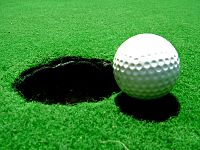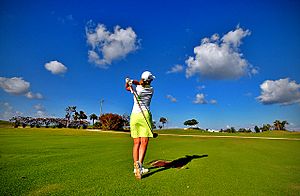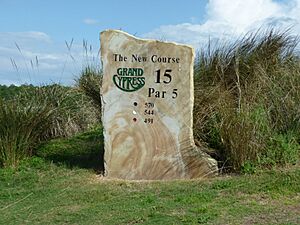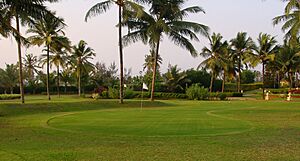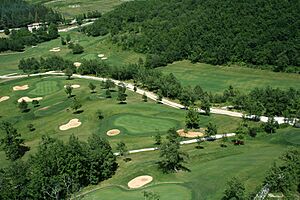Golf facts for kids
Golf is a game played in an open field where the golfer plays his golf ball into a hole by using different types of clubs (golf instruments). The book Rules of Golf reads "The Game of Golf consists in playing a ball from the teeing ground into the hole by a stroke or successive strokes in accordance with the Rules."
Contents
Rules and regulations
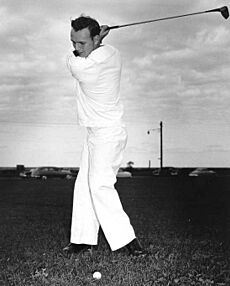
The rules of golf are internationally standardised and are jointly governed by The R&A, spun off in 2004 from The Royal and Ancient Golf Club of St Andrews (founded 1754), and the United States Golf Association (USGA). With the aim of simplifying the rules, in 2017 the USGA and R&A undertook a complete rewrite. The new rule book came into effect in January 2019.
The underlying principle of the rules is fairness. As stated on the back cover of the official rule book:
- Play the ball as it lies, play the course as you find it, and if you cannot do either, do what is fair.
There are strict regulations regarding the amateur status of golfers. Essentially, anybody who has ever received payment or compensation for giving instruction, or played golf for money, is not considered an amateur and may not participate in competitions limited solely to amateurs. However, amateur golfers may receive expenses that comply with strict guidelines and they may accept non-cash prizes within the limits established by the Rules of Amateur Status.
In addition to the officially printed rules, golfers also abide by a set of guidelines called golf etiquette. Etiquette guidelines cover matters such as safety, fairness, pace of play, and a player's obligation to contribute to the care of the course. Though there are no penalties for breach of etiquette rules, players generally follow the rules of golf etiquette in an effort to improve everyone's playing experience.
Penalties
Penalty strokes are incurred in certain situations and are counted towards a player's score as if there were extra swing(s) at the ball. Either one or two strokes are added for most rule infractions or for taking relief from various situations, with the "general penalty" defined as two-strokes, and disqualification for severe or repeated rule breaches. Examples include:
- A lost ball or a ball hit out of bounds (OB) results in a penalty of one stroke and distance (Rule 18.2).
- With the exception of certain circumstances, a one-stroke penalty is assessed if a player causes their ball to move (Rule 9.4).
- A one-stroke penalty is assessed if a player elects to take relief when their ball comes to rest within a red or yellow penalty area (Rule 17), or from an unplayable lie (Rule 19).
- A two-stroke penalty is incurred for making a stroke at the wrong ball (Rule 6.3c).
- A two-stroke penalty is incurred for hitting a fellow player's ball if both balls lay on the green prior to the stroke (Rule 11.1a).
- Disqualification can result from cheating, signing for a lower score, or failing to adhere to one or more rules that lead to improper play.
Equipment
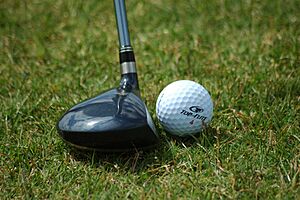
Golf clubs are used to hit a golf ball. Each club is composed of a shaft with a lance (or "grip") on the top end and a club head on the bottom. Long clubs, which have a lower amount of degree loft, are those meant to propel the ball a comparatively longer distance, and short clubs a higher degree of loft and a comparatively shorter distance. The actual physical length of each club is longer or shorter, depending on the distance the club is intended to propel the ball.
Golf clubs have traditionally been arranged into three basic types. Woods are large-headed, long-shafted clubs meant to propel the ball a long distance from relatively "open" lies, such as the teeing ground and fairway. Of particular importance is the driver or "1-wood", which is the lowest lofted wood club, and in modern times has become highly specialized for making extremely long-distance tee shots, up to 300 yards (270 m), or more, in a professional golfer's hands. Traditionally these clubs had heads made of a hardwood, hence the name, but virtually all modern woods are now made of metal such as titanium, or of composite materials. Irons are shorter-shafted clubs with a metal head primarily consisting of a flat, angled striking face. Traditionally the clubhead was forged from iron; modern iron clubheads are investment-cast from a steel alloy. Irons of varying loft are used for a variety of shots from virtually anywhere on the course, but most often for shorter-distance shots approaching the green, or to get the ball out of tricky lies such as sand traps. The third class is the putter, which evolved from the irons to create a low-lofted, balanced club designed to roll the ball along the green and into the hole. Putters are virtually always used on the green or in the surrounding rough/fringe. A fourth class, called hybrids, evolved as a cross between woods and irons, and are typically seen replacing the low-lofted irons with a club that provides similar distance, but a higher launch angle and a more forgiving nature.
A maximum of 14 clubs is allowed in a player's bag at one time during a stipulated round. The choice of clubs is at the golfer's discretion, although every club must be constructed in accordance with parameters outlined in the rules. (Clubs that meet these parameters are usually called "conforming".) Violation of these rules can result in disqualification.
The exact shot hit at any given time on a golf course, and which club is used to accomplish the shot, are always completely at the discretion of the golfer; in other words, there is no restriction whatsoever on which club a golfer may or may not use at any time for any shot.
Golf balls are spherical, usually white (although other colours are allowed), and minutely pock-marked by dimples that decrease aerodynamic drag by increasing air turbulence around the ball in motion, which delays "boundary layer" separation and reduces the drag-inducing "wake" behind the ball, thereby allowing the ball to fly farther. The combination of a soft "boundary layer" and a hard "core" enables both distance and spin.
A tee is allowed only for the first stroke on each hole, unless the player must hit a provisional tee shot or replay their first shot from the tee.
Many golfers wear golf shoes with metal or plastic spikes designed to increase traction, thus allowing for longer and more accurate shots.
A golf bag is used to transport golf clubs and the player's other or personal equipment. Golf bags have several pockets designed for carrying equipment and supplies such as tees, balls, and gloves. Golf bags can be carried, pulled on a trolley or harnessed to a motorized golf cart during play. Golf bags usually have both a hand strap and shoulder strap for carrying, others may be carried over both shoulders like a backpack, and often bags have retractable legs that allow the bag to stand upright when at rest.
Stroke mechanics
The golf swing is outwardly similar to many other motions involving swinging a tool or playing implement, such as an axe or a baseball bat. However, unlike many of these motions, the result of the swing is highly dependent on several sub-motions being properly aligned and timed. These ensure that the club travels up to the ball in line with the desired path; that the clubface is in line with the swing path; and that the ball hits the centre or "sweet spot" of the clubface. The ability to do this consistently, across a complete set of clubs with a wide range of shaft lengths and clubface areas, is a key skill for any golfer, and takes a significant effort to achieve.
Stance
Stance refers to how the golfer positions themselves in order to play a stroke; it is fundamentally important in being able to play a stroke effectively. The stance adopted is determined by what stroke is being played. All stances involve a slight crouch. This allows for a more efficient striking posture whilst also isometrically preloading the muscles of the legs and core; this allows the stroke to be played more dynamically and with a greater level of overall control. When adopting their stance golfers start with the non-dominant side of the body facing the target (for a right-hander, the target is to their left). Setting the stance in regard to the position of the ball, and placing the clubhead behind the ball, is known as being at address; when in this position the player's body and the centerline of the club face are positioned parallel to the desired line of travel, with the feet either perpendicular to that line or slightly splayed outward. The feet are commonly shoulder-width apart for middle irons and putters, narrower for short irons and wider for long irons and woods. The ball is typically positioned more to the "front" of the player's stance (closer to the leading foot) for lower-lofted clubs, with the usual ball position for a drive being just behind the arch of the leading foot. The ball is placed further "back" in the player's stance (toward the trailing foot) as the loft of the club to be used increases. Most iron shots and putts are made with the ball roughly centered in the stance, while a few mid- and short-iron shots are made with the ball slightly behind the centre of the stance to ensure consistent contact between the ball and clubface, so the ball is on its way before the club continues down into the turf.
Strokes
The golfer chooses a golf club, grip, and stroke appropriate to the distance:
- The "drive" or "full swing" is used on the teeing ground and fairway, typically with a wood or long iron, to produce the maximum distance capable with the club. In the extreme, the windup can end with the shaft of the club parallel to the ground above the player's shoulders.
- The "approach" or "3/4 swing" is used in medium- and long-distance situations where an exact distance and good accuracy is preferable to maximum possible distance, such as to place the ball on the green or "lay up" in front of a hazard. The windup or "backswing" of such a shot typically ends up with the shaft of the club pointing straight upwards or slightly towards the player.
- The "chip" or "half-swing" is used for relatively short-distance shots near the green, with high-lofted irons and wedges. The goal of the chip is to land the ball safely on the green, allowing it to roll out towards the hole. It can also be used from other places to accurately position the ball into a more advantageous lie. The backswing typically ends with the head of the club between hip and head height.
- The "putt" is used in short-distance shots on or near the green, typically made with the eponymous "putter", although similar strokes can be made with medium to high-numbered irons to carry a short distance in the air and then roll (a "bump and run"). The backswing and follow-through of the putt are both abbreviated compared to other strokes, with the head of the club rarely rising above the knee. The goal of the putt is usually to put the ball in the hole, although a long-distance putt may be called a "lag" and is made with the primary intention of simply closing distance to the hole or otherwise placing the ball advantageously.
Having chosen a club and stroke to produce the desired distance, the player addresses the ball by taking their stance to the side of it and (except when the ball lies in a hazard) grounding the club behind the ball. The golfer then takes their backswing, rotating the club, their arms and their upper body away from the ball, and then begins their swing, bringing the clubhead back down and around to hit the ball. A proper golf swing is a complex combination of motions, and slight variations in posture or positioning can make a great deal of difference in how well the ball is hit and how straight it travels. The general goal of a player making a full swing is to propel the clubhead as fast as possible while maintaining a single "plane" of motion of the club and clubhead, to send the clubhead into the ball along the desired path of travel and with the clubhead also pointing that direction.
Accuracy and consistency are typically stressed over pure distance. A player with a straight drive that travels only 220 yards (200 m) will nevertheless be able to accurately place the ball into a favourable lie on the fairway, and can make up for the lesser distance of any given club by simply using "more club" (a lower loft) on their tee shot or on subsequent fairway and approach shots. However, a golfer with a drive that may go 280 yards (260 m) but often does not fly straight will be less able to position their ball advantageously; the ball may "hook", "pull", "draw", "fade", "push" or "slice" off the intended line and land out of bounds or in the rough or hazards, and thus the player will require many more strokes to hole out.
Musculature
A golf stroke uses the muscles of the core (especially erector spinae muscles and latissimus dorsi muscle when turning), hamstring, shoulder, and wrist. Stronger muscles in the wrist can prevent them from being twisted during swings, whilst stronger shoulders increase the turning force. Weak wrists can also transmit the force to elbows and even neck and lead to injury. (When a muscle contracts, it pulls equally from both ends and, to have movement at only one end of the muscle, other muscles must come into play to stabilize the bone to which the other end of the muscle is attached.) Golf is a unilateral exercise that can break body balances, requiring exercises to keep the balance in muscles.
Types of putting
Putting is considered to be the most important component of the game of golf. As the game of golf has evolved, there have been many different putting techniques and grips that have been devised to give golfers the best chance to make putts. When the game originated, golfers would putt with their dominant hand on the bottom of the grip and their weak hand on top of the grip. This grip and putting style is known as "conventional". There are many variations of conventional including overlap, where the golfer overlaps the off hand index finger onto off the dominant pinky; interlock, where the offhand index finger interlocks with the dominant pinky and ring finger; double or triple overlap and so on. Recently, "cross handed" putting has become a popular trend amongst professional golfers and amateurs. Cross handed putting is the idea that the dominant hand is on top of the grip where the weak hand is on the bottom. This grip restricts the motion in your dominant hand and eliminates the possibility of wrist breakdowns through the putting stroke.
Other notable putting styles include "the claw", a style that has the grip directly in between the thumb and index finger of the dominant hand while the palm faces the target. The weak hand placed normally on the putter. Anchored putting, a style that requires a longer putter shaft that can be anchored into the player's stomach or below the chin; the idea is to stabilize one end of the putter thus creating a more consistent pendulum stroke. This style has been banned on professional circuits since 2016.
Scoring and handicapping
Par
A hole is classified by its par, which gives an indication of the number of strokes a skilled golfer may be expected to need to complete play of the hole. The primary factor for classifying the par of a relatively straight, hazard-free hole is the distance from the tee to the green, and calculates the number of strokes a skilled golfer is expected to require to reach the green with an additional allowance of 2 putts. As such, the minimum par of any hole is 3; one stroke for the tee shot and two putts. Par 3, 4 and 5 holes are commonplace on golf courses; far more rarely, courses may feature par-6 and even par-7 holes.
For men, a typical par-3 hole is less than 250 yards (230 m) in length, with a par-4 hole ranging between 251–450 yards (230–411 m), and a par-5 hole being longer than 450 yards (410 m); for women these boundaries are lower, and for professionals they are much increased. The rare par-6s can stretch well over 650 yards (590 m). These distances are based on the typical scratch golfer's drive distance of between 240 and 280 yards (220 and 260 m). Although length is the primary factor in calculating par, other factors are taken into account; however the number of strokes a scratch golfer should take to make the green remains foremost. Factors affecting the calculation include altitude, gradient of the land from the tee to green, and forced "lay-ups" due to dog-legs (sharp bends) or obstacles (e.g. bunkers, water hazards).
Getting the ball onto the green in two strokes less than par, and hence meeting the par calculation criteria, is called making "green in regulation" or GIR. Missing a GIR does not necessarily mean a golfer will not make par, but it does make doing so more difficult as it reduces the number of putts available; conversely, making a GIR does not guarantee a par, as the player might require three or more putts to "hole out". Professional golfers typically make between 60% and 70% of greens in regulation.
Eighteen-hole courses typically total to an overall par score of 70 to 72 for a complete round; with most holes having a par of 4, and a smaller number of par-3 and par-5 holes. Additionally, courses may be classified according to their play difficulty, which may be used to calculate a golfer's handicap. The two primary difficulty ratings in the U.S. are the Course Rating, which is the expected score for a zero-handicap "scratch golfer", and the Slope Rating, which is a measure of how much worse a "bogey golfer" (handicap around 20) would be expected to play than a "scratch golfer" relative to their handicap.
Scoring
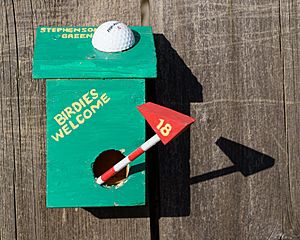
The goal is to play as few strokes per round as possible. A golfer's number of strokes in a hole, course, or tournament is compared to its respective par score, and is then reported either as the number that the golfer was "under-" or "over-par", or if it was "equal to par". A hole in one (or an "ace") occurs when a golfer sinks their ball into the cup with their first stroke from the tee. Common scores for a hole also have specific terms.
| Numeric term | Name | Definition |
|---|---|---|
| −4 | Condor | four strokes under par |
| −3 | Albatross (Double eagle) | three strokes under par |
| −2 | Eagle | two strokes under par |
| −1 | Birdie | one stroke under par |
| E | Par | equal to par |
| +1 | Bogey | one stroke over par |
| +2 | Double bogey | two strokes over par |
| +3 | Triple bogey | three strokes over par |
In a typical professional tournament or among "scratch" amateur players, "birdie-bogey" play is common; a player will "lose" a stroke by bogeying a hole, then "gain" one by scoring a birdie. Eagles are uncommon but not rare; however, only 18 players have scored an albatross in a men's major championship. One of the rarest feats in golf is the condor, which has never occurred in a professional tournament. Only five condors have been verified to have ever occurred, although none of the courses involved were professionally accredited.
Basic forms of golf
There are two basic forms of golf play, match play and stroke play. Stroke play is more popular.
Match play
Two players (or two teams) play each hole as a separate contest against each other in what is called match play. The party with the lower score wins that hole, or if the scores of both players or teams are equal the hole is "halved" (or tied). The game is won by the party that wins more holes than the other. In the case that one team or player has taken a lead that cannot be overcome in the number of holes remaining to be played, the match is deemed to be won by the party in the lead, and the remainder of the holes are not played. For example, if one party already has a lead of six holes, and only five holes remain to be played on the course, the match is over and the winning party is deemed to have won "6 & 5". At any given point, if the lead is equal to the number of holes remaining, the party leading the match is said to be "dormie", and the match is continued until the party increases the lead by one hole or ties any of the remaining holes, thereby winning the match, or until the match ends in a tie with the lead player's opponent winning all remaining holes. When the game is tied after the predetermined number of holes have been played, it may be continued until one side takes a one-hole lead.
Stroke play
The score achieved for each and every hole of the round or tournament is added to produce the total score, and the player with the lowest score wins in stroke play. Stroke play is the game most commonly played by professional golfers. If there is a tie after the regulation number of holes in a professional tournament, a playoff takes place between all tied players. Playoffs either are sudden death or employ a pre-determined number of holes, anywhere from three to a full 18. In sudden death, a player who scores lower on a hole than all of their opponents wins the match. If at least two players remain tied after such a playoff using a pre-determined number of holes, then play continues in sudden death format, where the first player to win a hole wins the tournament.
Popularity
In 2005, Golf Digest calculated that the countries with the most golf courses per capita, in order, were: Scotland, New Zealand, Australia, Ireland, Canada, Wales, the United States, Sweden, and England (countries with fewer than 500,000 people were excluded).
The number of courses in other territories has increased, an example of this being the expansion of golf in China. The first golf course in China opened in 1984, but by the end of 2009, there were roughly 600 golf courses in China. For much of the 21st century, the development of new golf courses in China has been officially banned (with the exception of the island province of Hainan), but the number of courses had nonetheless tripled from 2004 to 2009; the "ban" has been evaded with the government's tacit approval simply by not mentioning golf in any development plans.
In the United States, women made up 25 percent of golfers in 2021, which was up from 19 percent since 2011 and junior female golfers account for 35 percent or 1.1 million golfers.
In the United States, the number of people who play golf twenty-five times or more per year decreased from 6.9 million in 2000 to 4.6 million in 2005, according to the National Golf Foundation. The NGF reported that the number who played golf at all decreased from 30 to 26 million over the same period.
In February 1971, astronaut Alan Shepard became the first person to golf anywhere other than on Earth. He smuggled a golf club head and two golf balls on board Apollo 14 in order to play golf on the Moon. He attached the head to a tool for collecting rock samples, and attempted two drives. He shanked the first attempt, but it is estimated his second went 40 yards (37 m).
Olympic Games
Golf was featured in the Summer Olympic Games official programme in 1900 and 1904. After a 112-year absence, golf returned for the 2016 Rio Games. The International Golf Federation (IGF) is recognised by the International Olympic Committee (IOC) as the world governing body for golf.
Women
It was not until 1552, that the first woman golfer played the game. However, it was not until the 20th century that women were taken seriously and eventually broke the "Gentlemen Only, Ladies Forbidden" rule. Many men saw women as unfit to play the sport due to their supposed lack of strength and ability.
In 1891, the newly built Shinnecock Hills nine-hole course in Southampton, New York became the first club to offer membership to women golfers. Four years later, in 1895, The U.S. Golf Association held the first Women's Amateur Championship tournament.
As of 2016, women golfers were still fighting to have the same opportunities as male golfers. There is still a significant pay gap in the USGA. The USGA has a long history of awarding more prize money to winners of the men's U.S. Open, than the U.S. Women's Open.
International events
- Golf at the Asian Games
- Curtis Cup
- EurAsia Cup
- International Crown
- Golf at the Summer Olympics
- Golf at the Pan American Games
- Presidents Cup
- Ryder Cup
- Seve Trophy
- Solheim Cup
- Golf at the Summer Universiade
- Walker Cup
Images for kids
-
The Xuande Emperor of the Ming dynasty playing chuiwan
-
Indoor putting green for practice and instruction
-
Gary Player is widely regarded as one of the greatest players in the history of golf.
-
Lorena Ochoa, a retired number one female golfer, pictured here in 2007
See also
 In Spanish: Golf para niños
In Spanish: Golf para niños


